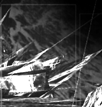
Ulrike
Gabriel
Perceptual Arena
by
Otherspace
gabriel@em.uni-frankfurt.de


Perceptual Arena is a realtime environment. In the
default state completely empty, it creates an audio visual space texture as a
coding of the user interaction. The interaction is simply to be in the space, to
perceive it, to move around and grasp the resulting virtual clay, which defines
the space and is the material for the further interaction.
The space
correlates the individual perception and the perceived. The perceivable evolves
through perception of it. To intervene in this process transforms the world, but
can also push it out of balance and therefore destroy.
The world of polygons
and sounds is created and constantly changed by the personal views, it only
exists through the viewer.
Factors:
The complexity of the
arena world results out of the total interrelation of all itīs factors which in
the end all depend on the users input data.
The factors are:
the users view onto the space
the users movement in the space
a
history of movement and view
the activity of a virtual sensor in the field
of view which applies movement and viewing history onto the space
the total
access with a data glove onto the space through the field of view
the
virtual clay which is object and result of all this factors
Perceptual
Arena is a realtime environment. In the default state completely empty, it
creates an audio visual space texture as a coding of the user interaction. The
interaction is simply to be in the space, to perceive it, to move around and
grasp the resulting virtual clay, which defines the space and is the material
for the further interaction. The space correlates the individual perception and
the perceived. The perceivable evolves through perception of it. To intervene in
this process transforms the world, but can also push it out of balance and
therefore destroy. The world of polygons and sounds is created and constantly
changed by the personal views, it only exists through the viewer. Factors: The
complexity of the arena world results out of the total interrelation of all itīs
factors which in the end all depend on the users input data. The factors are:
the users view onto the space the users movement in the space a history of
movement and view the activity of a virtual sensor in the field of view which
applies movement and viewing history onto the space the total access with a data
glove onto the space through the field of view the virtual clay which is object
and result of all this factors Viewing existing polygons triggers their
structural change. The interface between things in space and the personal view
is a virtual sensor. It slides over the world with the view and activates the
perceived polygons. The veiwign history influences how polygons react. Any
contemporary influence becomes historical and it can initialize further
unpredictable changes. The more intense the view on a part of the space is, the
more active the virtual sensor gets in this area and the more it causes the
structure to unfold. Activated polygons start to move, they organize into
clusters, get connected to each other or cell into multiples. The cpmplexity of
the resulting virtual clay of structures is determined by the view. If polygons
are outside the view they die after a certain lifetime 



